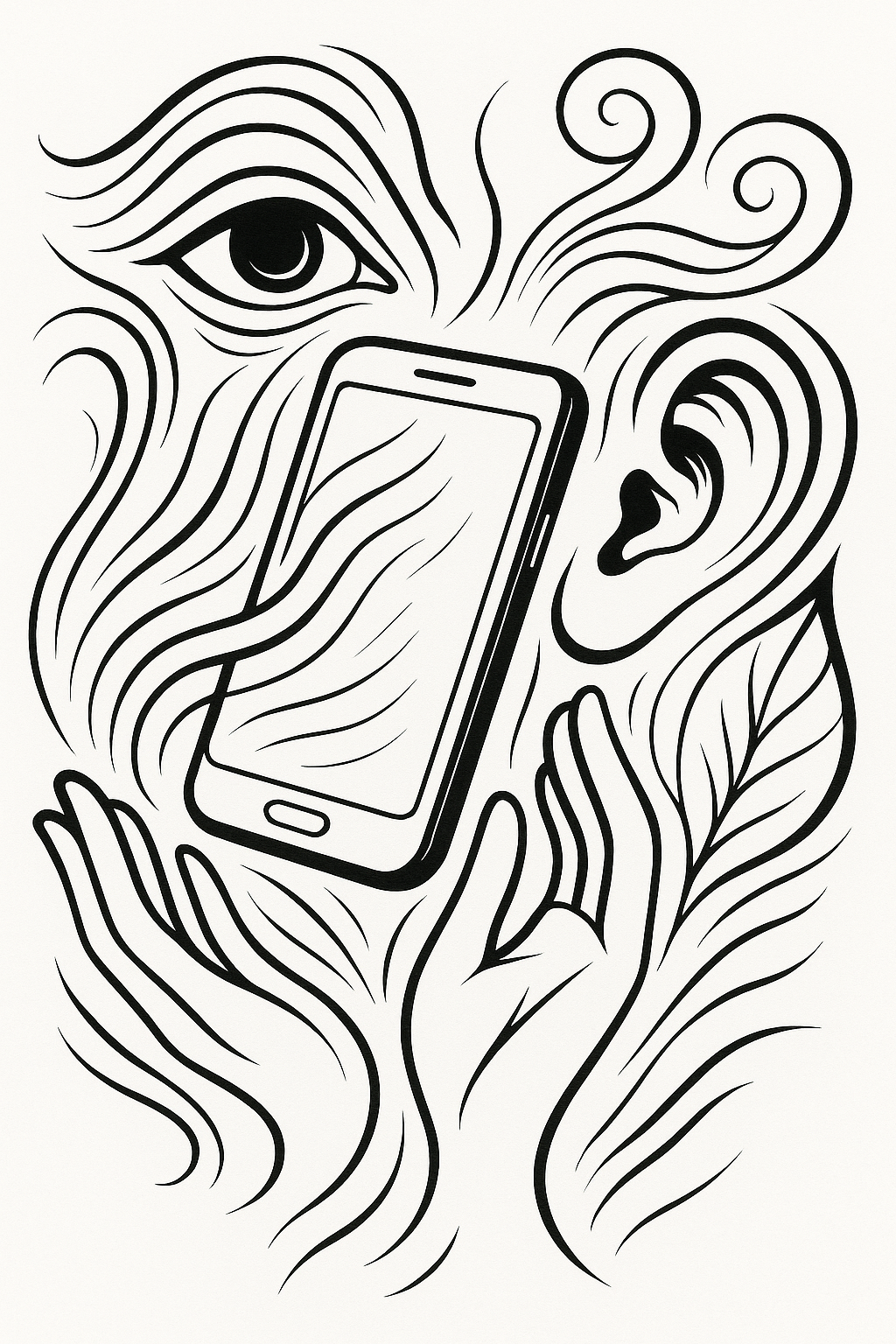Phones are powerful tools, but they’re also magnets for attention. It’s easy to reach for a screen during pauses—waiting in line, between emails, or just before bed—and suddenly five minutes disappear. The “Screens to Senses” swap offers a gentle reset: replace one mindless scroll with one mindful sensory check-in. No extra time. No perfection needed. Just a small shift that brings attention back to the moment.
Why This Simple Swap Works
Breaks the habit loop: Scrolling often starts from boredom, stress, or transition moments. A quick sensory check-in interrupts autopilot and resets the nervous system.
Grounds the body: Noticing sights, sounds, textures, and breath signals safety. The body steadies, and the mind follows.
Builds real presence: Each swap recovers a little attention, helping the day feel clearer and more intentional.
This isn’t about ditching devices. It’s about reclaiming tiny bits of awareness and bringing them home—one moment at a time.
When to Try It
In micro-moments: waiting for a kettle to boil, riding an elevator, standing in line.
Between tasks: after closing a tab, before opening a new app, or switching from work to dinner.
At common triggers: restlessness, worry, boredom, or the urge to “just check.”
Choose one daily moment to practice. A small, consistent cue works better than random effort.
Three Easy Sensory Check-Ins
Each takes under a minute. Pick one and keep it simple.
Five Senses Reset (30–60 seconds)
Name 3 things seen (colors, shapes, light).
Name 2 things felt (clothes on skin, feet on floor, air on face).
Name 1 sound heard (near or far).
Option: Add one slow, steady exhale.
4–6 Breathing + Soften (20–40 seconds)
Inhale for a count of 4, exhale for a count of 6.
On the exhale, soften one area: jaw, shoulders, belly, or hands.
Single-Anchor Focus (15–30 seconds)
Choose one anchor: warmth of a mug, sensation of breath at the nostrils, or ambient sound.
Stay with it for 3–5 breaths, gently returning when the mind wanders.
The goal is not intensity; it’s consistency. One swap done daily has more impact than an ambitious routine that fades.
A One-Week Mini Challenge
Day 1: Swap the first morning scroll for 3 slow breaths by a window.
Day 2: Before opening a social app, do the 3-2-1 senses check.
Day 3: At lunch, put the phone down for the first 2 minutes; notice temperature, texture, and taste.
Day 4: After a meeting, feel both feet on the ground for 5 breaths.
Day 5: In a line, trace the edges of 5 objects with the eyes instead of checking notifications.
Day 6: Before bed, try 4–6 breathing with one hand resting on the belly.
Day 7: Repeat the favorite practice twice today.
Consider adding a lock-screen reminder: “Swap: Screens → Senses.”
Make It Stick with Gentle Design
Habit pairing: Tie the check-in to a routine action—unlocking the phone, closing the laptop, or sitting down to eat.
Reduce friction: Move social apps off the home screen and place a notes widget or breath timer where the thumb naturally lands.
Track feelings, not streaks: After each swap, ask, “Do things feel 5% calmer or clearer?”
Celebrate small: Mentally tag it as a win—“Presence chosen.”
These small signals shape behavior more reliably than willpower alone.
What to Expect
Early days: Restlessness and the pull to check again. Totally normal.
After a week: Brief pockets of calm appear more often, with less compulsive tapping.
Over time: Smoother task transitions, a steadier mood, and more space to choose the next kind action.
Progress looks like micro-moments, not dramatic breakthroughs. The nervous system learns through repetition and kindness.
Variations for Different States
Stressed: 4–6 breathing + relax the shoulders on each exhale.
Tired: Splash cool water on the wrists, look at something green, or open a window.
Overstimulated: Close the eyes for 10 seconds; listen for the farthest sound.
Lonely: Place a hand over the heart and lengthen the exhale; send a short, sincere message to someone.
Adjust the practice to meet the moment. The right tool is the one that gets used.
A Gentle Reframe
The goal isn’t to be anti-screen. It’s to be pro-awareness. One swap won’t change everything, but it will change that moment—and moments stack. Over days and weeks, these small check-ins add up to a steadier, kinder way of moving through the day.
To explore more simple, grounded practices like this, Journey Through Meditation offers a practical guide to weaving mindfulness into real life. It’s accessible, down-to-earth, and designed for busy schedules. Journey Through Meditation — grab a copy here.

